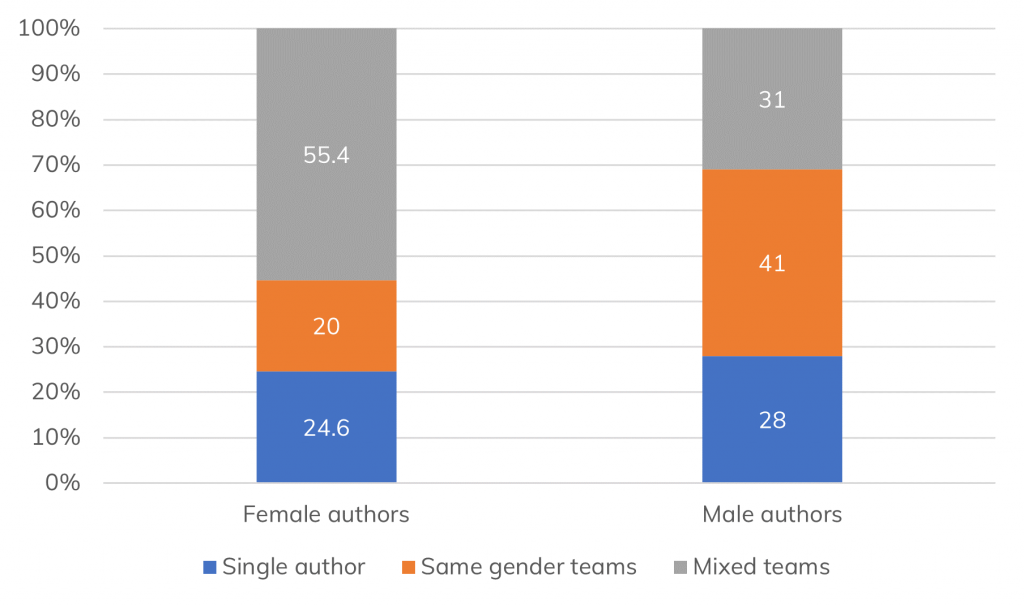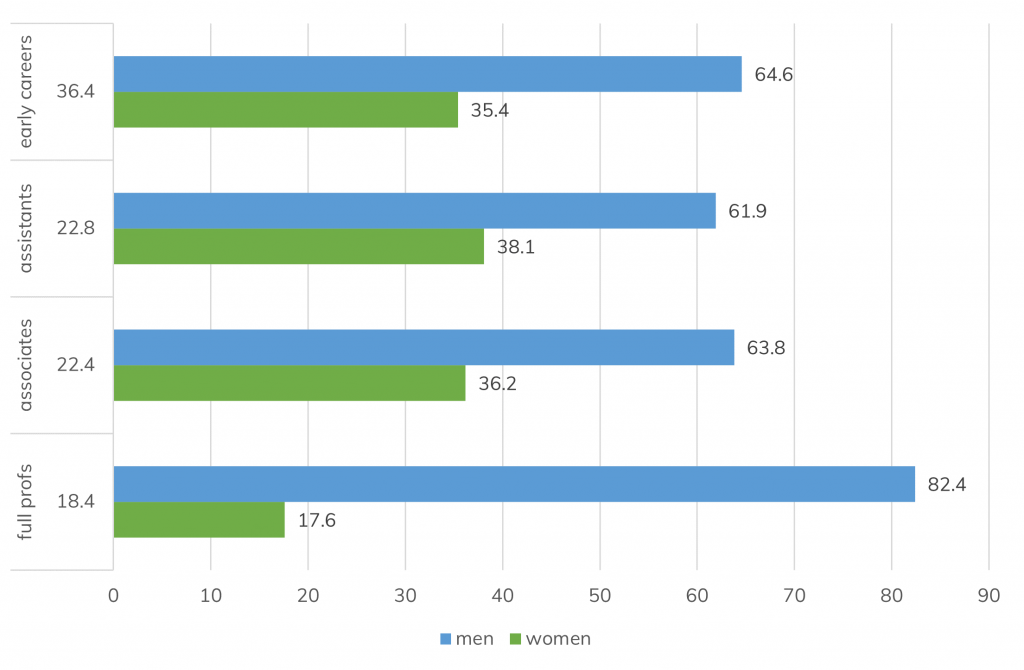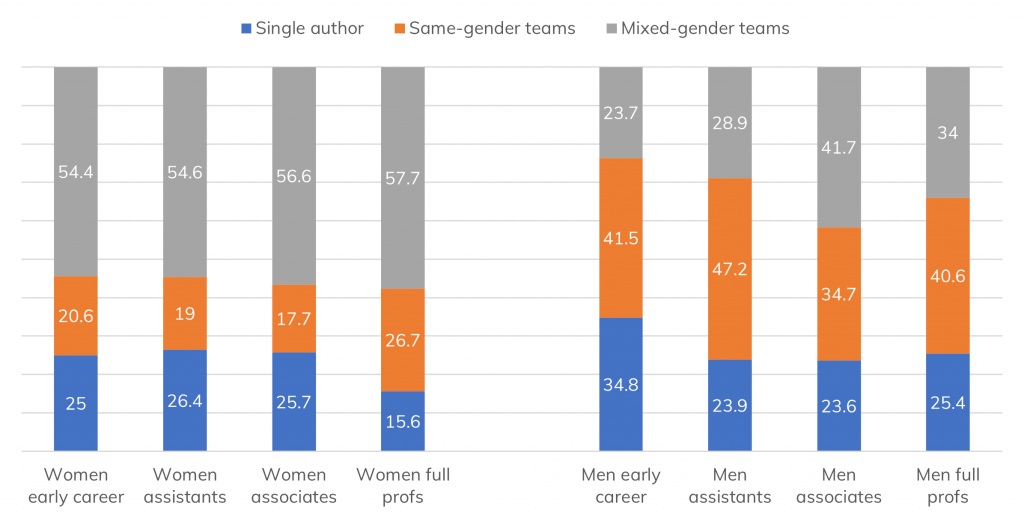There is a clearly established numerical predominance of male authors in political science journals. Anna Bosco and Susannah Verney show that this gender gap applies at every career stage, and is accompanied by gendered publication strategies which may not offer women the optimum path to career success
When it comes to publishing in top political science journals, in Europe and in the United States, male authors outnumber their female colleagues by around two to one. Previous research has shown that the numerical differential arises at the point of submission. Women submit far fewer articles than men. This may indicate that behind the gender gap lies a confidence gap. But are fewer submissions the only aspect of this?
If we are to redress the gender imbalance in academic publishing, we need a better understanding of women’s choices regarding academic publication. Our previous research used data from the journal South European Society and Politics (SESP). With this, we conducted an initial investigation into men’s and women’s publication strategies, and found that they are different. Women seemed to have a clear preference for co-publication with male authors, while men opted more often for solo authorship or co-authoring with other men.
Women seemed to have a clear preference for co-publication with male authors, while men opted more often for solo authorship or co-authoring with other men
In our new research with Sandra Bermúdez Torres and Annalisa Tonarelli, we wanted to establish whether the picture we had found at one journal would be replicated elsewhere. But we also wanted to take our investigation further, examining how authors’ career stage affected gendered publication choices.
We expanded our database to include, alongside SESP, the official journals of the national political science associations of Italy and Spain, Rivista Italiana di Scienza Politica (RISP) and Revista Española de Ciencia Política (RECP). Between 2011 and 2022, these three journals published a total of 794 articles, which involved 1,395 authors. Of the published scholars, just 459, or 32.9% of the total, were women. The gender gap was confirmed.

Figure 1 shows our aggregate findings with regard to publication strategies. The absolute majority (55.4%) of articles published by women are co-authored with male colleagues. In contrast, less than a third of articles published by men were written in collaboration with women. Instead, the male choice is overwhelmingly (69%) for solo authorship or writing with other men. This is a striking difference from the 44.6% of women’s articles written alone or with other women.
This reveals another dimension of the gender gap, which is not limited only to women’s overall numerical presence. It shows that for women, working with men is much more important to academic publication success than working with women is for men.
These differences intrigued us. Were these lifetime choices, or did they vary according to career stage? This is a particularly important question in relation to early career scholars, for whom visibility and affirmation in the academic community is particularly important.
To investigate this, we identified the career stage of each author at the time their article was published. We divided academic careers into four categories. ‘Early career scholars’ includes pre-PhD researchers or PhD-holders who are not yet in a tenure-track post. ‘Assistants’ includes Assistant Professors and other scholars on career-track contracts. Finally, the senior ranks consist of the two classes of ‘Associate’ and ‘Full Professors’.

Figure 2 shows how early career scholars are the most important individual group of authors. They make up 36.4% of the total, followed by assistant professors (22.8%). Most importantly, the figure reveals that at each step of the academic ladder, male authors overwhelmingly dominate. In other words, the gender gap is a lifetime condition in political science. The small proportion of women among full professors is not so surprising as they are a minority at this career stage. Furthermore, this can be regarded as a legacy issue, deriving from the past of the profession in which male full professors heavily outnumbered women.

How does this gender gap interrelate with publication strategies? Figure 3 highlights male and female publication choices at each career stage. What is really striking is the consistency of women’s preference, regardless of their academic seniority, to co-author with men. As the graph shows, the percentage of women who publish with male colleagues hardly varies, from 54.4% among those at the beginning of their careers, to 57.7% at full professor stage. For male academics, on the other hand, co-authoring in mixed-gender teams is always significantly less important than it is for women. Proportions range between 23.7% for early career scholars to 41.7% for associate professors.
It is particularly relevant to look at how men and women choose to start their careers. Single-author articles are vital for establishing scholars’ reputations. With solo authorship, academics introduce and defend their research, taking full responsibility – and full credit – for what they publish.
Yet at this crucial point in their careers, as Figure 3 shows, only a quarter of the women authors published in the three journals publish alone. This contrasts with more than a third of male early career scholars. The inference is that younger female scholars may not be choosing the best strategy to further their careers.
Overall, when it comes to publishing in top political science journals, our research confirmed that the well-established numerical difference in publications by women and male authors applies at every stage in the academic career. In addition, we found that women’s weaker publication footprint has another dimension: a gendered ‘publication strategy gap’. This involves women at all stages of their academic careers making a choice to work primarily with men.
Junior female academics should be encouraged to publish more – and to publish solo
There may be many reasons for this, but identifying them would require different research tools, including interviews and possibly focus groups. However, our assumption is that women’s lack of confidence might play a role in it.
In order to address the gender imbalance, we believe that attempts to address the confidence gap would be especially relevant at the early career stage. Junior female academics should be encouraged to publish more – and to publish solo. Professional associations, academic journals and university mentors need to think creatively about how to reach this goal.
Blaming women for being less confident and for choosing the wrong career strategies puts the responsibility for the gender gap in academia on women alone and not on the institutionalised structures that create those imbalances. I think one important factor that should be considered is the question of full time vs part time contracts and children. The already existing gender gap increases significantly the moment women have children (at any career stage). Combining a career with a family continues to be an almost impossible endeavor for women while most men are very little affected by the arrival of children and continue to publish as before.
Thank you very much for your message. We could not agree more with you on the importance of contracts and children. Our research, however, is not on the factors at the base of the gender gap, but on the different publication strategies chosen by male and female academics along their whole careers.